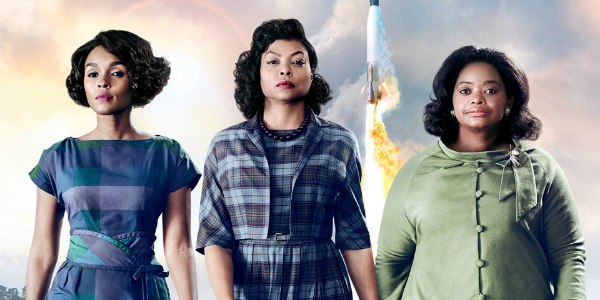Write Readers, let’s talk about a film that has gotten so much buzz you’d think it was guaranteed to win. Ladies and gentlemen, this is Hidden Figures.
 Hidden Figures is a film written by Theodore Melfi and Allison Schroeder, and based on the book of the same name by Margot Lee Shetterly. Directed by Melfi, the film stars Taraji P. Henson, Octavia Spence, and Janelle Monae, along with Kevin Costner, Kirsten Dunst, Jim Parsons, Glen Powell, and Mahershala Ali. The film was nominated for three Oscars, Best Picture, Best Adapted Screenplay, and Best Supporting Actress for Octavia Spencer. Are you ready? Here’s what happened. (Spoilers ahead)
Hidden Figures is a film written by Theodore Melfi and Allison Schroeder, and based on the book of the same name by Margot Lee Shetterly. Directed by Melfi, the film stars Taraji P. Henson, Octavia Spence, and Janelle Monae, along with Kevin Costner, Kirsten Dunst, Jim Parsons, Glen Powell, and Mahershala Ali. The film was nominated for three Oscars, Best Picture, Best Adapted Screenplay, and Best Supporting Actress for Octavia Spencer. Are you ready? Here’s what happened. (Spoilers ahead)
In 1961, Katherine G. Johnson (Taraji P. Henson) works as a computer (one who makes calculations) in the West Area Computers black division of Langley, along with her colleagues, Mary Jackson (Janelle Monae) and acting supervisor Dorothy Vaughan (Octavia Spencer). The Russians have successfully launched a satellite into space, and the space race is now begun in earnest. Katherine becomes the first African-American woman to join the Space Task Group, led by Al Harrison, who is played by Kevin Costner. Katherine’s new colleagues don’t take her seriously, especially the head engineer Paul Stafford, who is played by Jim Parsons. Katherine gets a lot of grief from all of her colleagues, and struggles to run across the campus to the segregated portion of the building just to use the bathroom, because there are no “colored” facilities in this building. Dorothy is equally struggling with racial adversity – although she acts as the supervisor and does the work of a supervisor, she is not paid as one. Although she has applied to Mrs. Mitchell (Kirsten Dunst) time and time again to become the official supervisor, she is continually rejected. Mary Jackson is smart enough to be an engineer, and plays a key role in working with the team on working on the space capsule, but does not think NASA would permit her to become an engineer.
Lots of race-related struggles (as well as gender-related struggles) happen. Mary tries to become an engineer, but NASA invents an elaborate method to keep her from becoming one, by suddenly creating a new requirement that all applicants must have taken advanced coursework from one of two all-white schools. Not only does Dorothy not get promoted to supervisor, she learns that NASA has purchased an IBM, which is going to replace her and all of the other computers in the building. Because this is an inspiring movie about black women overcoming adversity, Katherine manages to prove herself indispensable over and over again, creating complex calculations, getting herself invited into Pentagon meetings, and doing a lot of difficult things for which she receives zero credit. All the while, she’s parenting three children, and has time to meet a handsome National Guard officer named Jim Johnson (Mahershala Ali) and start a relationship with him. Clearly, this woman never sleeps. Mary decides she is not going to let the man keep her down, so she decides to take her case to court in order to be allowed to take the required engineering courses at night in the all-white school. Dorothy, meanwhile, checks out a book about FORTRAN (clearly this is some sort of computing training manual) from the library, after being yelled at for being outside the colored section, and teaches herself and all of the other computers how to program the IBM so they still have jobs.
Race-relations are still difficult because it’s still the 1960s. These ladies continue to struggle. Katherine is told she is no longer needed in the Space Task Group so she goes back to the West Area group she was in before. But of course, something goes wrong with the IBM’s calculations and charming astronaut John Glenn (Glen Powell) insists that Katherine be called in to double-check the results. She is, of course, correct as usual, and even gets to stay and take part in helping Glenn get back from space after a warning light goes off. Mary makes it through her night courses and is allowed to become an engineer, and Dorothy is finally promoted to supervisor and brings all of the computers with her in order to run the IBM, which no one knows how to do but her and her girls. All is well in the world, we can assume, at least until Dr. King and President Kennedy get shot. Whelp.
This movie was problematic for me. I’m coming from a place of being a woman of mixed race, and I have a hard time watching movies like this. But before I talk about that, let’s talk about what makes this movie great, because a lot of things make it great.
Taraji P. Henson is absolutely wonderful in this film. To me, she is particularly wonderful because we get to see another side of her, a different side, the side we don’t see in Empire. For any of you who watch the show, in it Henson is fierce. She is scheming, conniving, complicated, sometimes caustic, and has all of the “YAAAS QWEEN SLAAAYY” moments anyone could ever ask for. In short, she’s going all out. In Hidden Figures, she is none of those things. She is well-behaved, mild-mannered, quiet, bookish, and sweet. When she opens up to her future husband Jim Johnson, we see her confidence, but it’s not at all like the Cookie we’re accustomed to getting. It’s always wonderful to get to have a different side of an actor, particularly one who may be a little type cast in her current television role. Really all of the female leads are wonderful. Janelle Monae is saucy and sassy, bringing that sweetness we see from her in Moonlight into her lovable yet incorrigible Mary Johnson at NASA. In particular I love her relationship with her husband. It defies the notion that relationships in that era had to be buttoned up and formal. They work with each other in such a familiar, loving way. I would say that surprisingly, my least favorite performance would Octavia Spencer’s, odd since she’s the one who got the nod for Best Supporting Actress. I can’t say that Spencer’s performance was poor, it just wasn’t as memorable for me as it could have been. Spencer is warm, motherly, and industrious, but there weren’t any noteworthy moments that truly stayed with me.
The challenge, for me, in watching this film, was that there were certainly moments in which I felt like absolutely nothing has changed. At the very opening, we see that Dorothy’s car has broken down, and she is working to fix it. The women hear a siren in the distance, and all straighten up as they see a police officer approaching. Mary asks, “What? Ain’t no crime in a broken down car!” And the response is, “Ain’t no crime in being a negro, neither.” (This is an approximation of the line.) That line hurt my soul. It certainly feels criminal, at times, to be a person of color in this country. It was definitely painful to watch the film. However, the film is generally inspiring, and I would encourage it to be incorporated into any classrooms, possibly for Black History Month.


